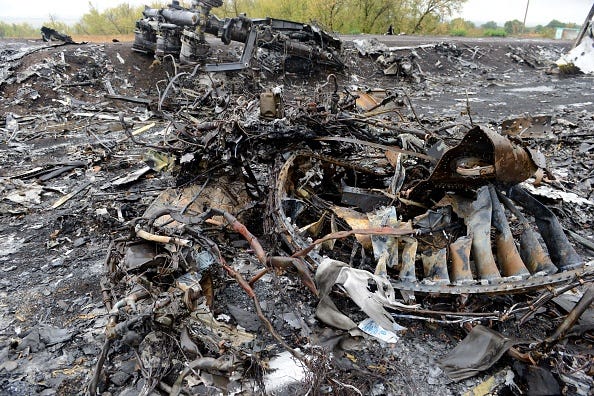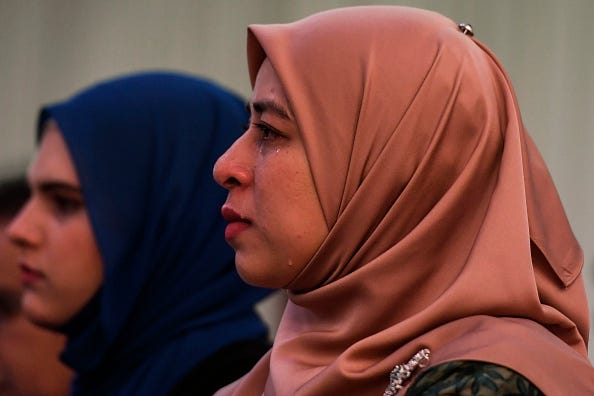On July 17th, 2014, a civilian airliner was shot down over Ukraine, killing all aboard.
Yesterday in the Netherlands, three men were found guilty of murdering the 298 passengers and crew aboard Malaysian Airlines Flight 17. The Dutch court found that the military forces who had fired the shot from an anti-aircraft battery on Ukrainian territory were under Russian command. Two of the three men found guilty were Russian citizens; one was a Ukrainian citizen who was fighting on the Russian side.
Other Russians were of course involved in the chain of events that led to the murder of the passengers and crew. The specific crime implies the more general one. Russia was invading southern and southeastern Ukraine at the time. In 2014, far too many people in Europe and North America overlooked this basic reality, which weakened the reaction to Russia’s clear and unambiguous violation of the most basic strictures of international law.
Below I will quote a few paragraphs of what I wrote five years ago about this, on the basis of sources available at the time. I took some care then (in my book Road to Unfreedom) to document how Russian propaganda reacted to the event. It is worthwhile to be reminded of the propaganda moves that Russia made at the time, because they demonstrate how the system responds to stress.
It is under more stress now. Russian propaganda is less persuasive than in 2014; the horrors are far greater, and the absence of the most skilled of the propagandists, Vladislav Surkov, is felt. The Ukrainians are much better now than they were in 2014 of getting their perspectives across. We in the United States are less gullible than we were during that first invasion.
The basic Russian tactics today are the same as those of 2014: serve up flamboyantly contradictory lies, in the expectation that something will stick somewhere, and that at the very least the obvious will become muddled and the simple will seem complex. Westerners are supposed to feel uncertain about what happened, and Russians are supposed to feel certain of their innocence. That feeling of innocence, the notion that it is somehow Putin and the Russians who are the real victims of war, is very important now.
The narration below takes up after the successful Russian operation in Crimea (February-March 2014), and during the subsequent Russian attempts to seize power in further Ukrainian regions, which generally failed. Russia deployed significant armed force in two of these regions, Luhans’k and Donets’k (the Donbas). Igor Girkin, who was convicted today, was a Russian commander in the Donbas. He is responsible for far more deaths than those 298. It was he who deliberately provoked the artillery war in the Donbas (this is also a subject of the book).
After the events described here, Russian forces would arrive in large numbers in summer 2014 and winter 2015 to secure gains in the Donbas. One of the (numerous and contradictory) grounds Putin has given for the full-scale invasion of 2022 was the protection of those territories, which Russian claims are states.
I have added a few explanatory remarks in brackets. In the book, the shooting down of MH17 and the coverup are used to make larger points about Putin’s style of rule.
“A crucial Russian weapons system delivered from Russia and deployed by Russian soldiers [in Ukraine] was anti-aircraft batteries. These changed the course of the [Russo-Ukrainian] war in May and June 2014. The Ukrainian army, small as it was, was routing the Russians and their local allies, so long as it maintained control of the air. In May, Russia began to supply anti-aircraft weapons and the teams that operated them, and the Ukrainian air force was quickly depleted. In May four helicopters were shot down; in June two fixed-wing aircraft were shot down, in July four fixed-wing aircraft. The Ukrainian command had to cease flying over the Donbas, which gave the Russians their chance.[i]
One of the numerous Russian military convoys left its base in Kursk on 23 June 2014. It was a detachment of the Russian 53rd Air Defense Brigade, bound for Donetsk with a BUK anti-aircraft missile system marked "332." On the morning of 17 July, this BUK system was hauled from Donetsk to Snizhne, then brought under its own power to a farmstead south of that town. Meanwhile, Malaysian Airlines Flight 17, bound for Kuala Lampur from Amsterdam, was crossing over southeastern Ukraine. It was flying on an authorized route, at a normal altitude, in regular contact with air traffic controllers -- until a ground-to-air missile suddenly destroyed it.[ii]
At 1:20pm, Malaysian Airlines Flight 17 was struck by hundreds of high-energy metal projectiles released from the explosion of a 9N314M warhead carried by a missile fired from that Russian BUK launcher at Snizhne. The projectiles ripped through the cockpit and instantly killed the pilots, from whose corpses some of the metal was later extracted. The aircraft flew apart ten kilometers above the earth's surface, its passengers and their possessions scattered over a radius of fifty kilometers. Igor Girkin [the local Russian commander, just found guilty, and fighting again now in Ukraine] boasted that his people had shot down another plane over "our sky," and several other commanders made similar remarks. Another separatist commander, Alexander Khodakovskii, told the press that a Russian BUK was active in the theater at the time. The BUK was hastily withdrawn from Ukraine back to Russia, photographed along the way with an empty missile silo. What had happened was quite clear.[iii]
The law of gravity seemed to challenge, at least for a few hours on the afternoon of 17 July 2014, the laws of eternity [I mean the politics of eternity, a concept I use in the book for political gambit of locating politics in a mythical past when the nation was innocent]. Surely the passengers who died were the victims, not the Russian soldiers who fired the missile? Even the Russian ambassador to the United Nations was thrown for a moment, using the excuse of "confusion" to explain how a Russian weapon had brought down a civilian airliner. Yet [Vladislav] Surkov's apparatus acted quickly to restore the Russian sense of innocence. In a typical mark of tactical brilliance, Russian television never denied the actual course of events: that a Malaysian airliner had been brought down by a Russian weapon fired by Russian soldiers taking part in an invasion of Ukraine. Denying the obvious only suggests it; defeating the obvious means engaging it from the flanks, like so many crows attacking a hawk. Even under stress, Russian media managers had the presence of mind to try to change the subject by inventing fictional versions of what had happened.[iv]
On the very day the plane was shot down, all of the major Russian channels blamed a "Ukrainian missile" or perhaps a "Ukrainian aircraft," for the downing of MH17, and claimed that the "real target" had been "the president of Russia." The Ukrainian government, according to the Russian media, had planned to assassinate Putin, but by accident had shot down the wrong plane. None of this was vaguely plausible. The two planes were not in the same place. The failed assassination story was so ludicrous that RT, after trying it on foreign audiences, did not pursue it. But within Russia itself, the moral calculus was indeed reversed: by the end of a day on which Russian soldiers had killed 298 foreign civilians during a Russian invasion of Ukraine, it had been established that Russia was the victim.[v]
The following day, 18 July 2014, all the channels of Russian television scattered new versions of the event. Myriad inventions were added to the multiple fictions, not to make any of them coherent, but to introduce further doubts about simpler and more plausible accounts. Thus three Russian television channels claimed that Ukrainian air traffic controllers had asked the pilots of MH17 to reduce their altitude. This was an invention. Later one of the networks claimed that Ihor Kolomois'kyi, a Ukrainian Jewish oligarch who was the governor of Dnipropetrovsk region, was personally responsible for issuing the (fictional) order to the air traffic controllers. In an echo of Nazi racial profiling, another network later provided an "expert" on "physiognomy" who claimed that Kolomois'kyi's face demonstrated his guilt.[vi]
Meanwhile, five Russian television networks, including some that had peddled the air-traffic control story, claimed that Ukrainian fighter aircraft had been on the scene -- although they could not get straight just which kind of aircraft this might have been; they provided pictures of various jets (taken at various places and times), and proposed altitudes that were impossible for the aircraft in question. The claim about the presence of fighter planes was untrue. A week after the disaster, Russian television generated a third version of the story of the downing of MH17: Ukrainian forces had shot it down during training exercises. This too had no basis in fact. Girkin then added a fourth version, claiming that Russia had indeed shot down MH17 -- but that no crime had been committed, since the CIA had filled the plane with corpses.[vii]
These fictions were raised to the rank of Russian foreign policy. When asked about MH17, Russian Foreign Minister Sergei Lavrov repeated the inventions of Russian media about air traffic controllers and nearby Ukrainian fighters. Neither of his claims were backed by evidence and both were untrue.[viii]
Russian media accounts were impossible not only as journalism but also as literature. If one tried to accept, one by one, the claims of Russian television, the fictional world thus constructed would be impossible, since its various elements could not coexist. It could not be that the plane had been shot down both from the ground and from the air. If it had been shot down from the air it could not have been shot down by both a MiG and an Su25. If it had been shot down from the ground this could not have been the result of both a training accident and an assassination attempt. Indeed, the Putin assassination story contradicted everything else that the Russian media claimed. It made no sense to say that Ukrainian air traffic controllers had communicated with the Malaysian pilots of MH17 as part of a plot to shoot down the Russian presidential aircraft.
But even if all of these lies could not make a coherent story, they could at least break a story, one that happened to be true. Although there were Russians who grasped what had happened and apologized, the Russian population as a whole was denied the possibility to reflect on its responsibility for a war and its crimes. According to the surveys of the one reliable sociological institute in Russia, 86% of Russians blamed Ukraine for shooting down MH17 in September 2014, and 85% continued to do so in July 2015, by which point the actual course of events had been investigated and was clear. Russian media urged Russians to be outraged that they were falsely blamed.[ix]”
Reminder: what follows are notes from a text completed in 2017. Today we know more, thanks to the multinational investigation of the Joint Investigation Team and other valuable work.
[i] Michael Weiss and James Miller, "How We Know Russia Shot Down MH17," Daily Beast, 17 July 2015; Miller et al., “An Invasion by Any Other Name,” pp. 17-34.
[ii] The Russian detachment: "Pre-MH17 Photograph of Buk 332 Discovered," Bellingcat, 5 June 2017; Wacław Radzinowicz, "Donbas, Syria, zestrzelony boeing," Gazeta Wyborcza, 31 May 2017.
[iii] For further supporting detail see Bellingcat Investigation Team, "MH-17," 3-16, 36-44, and passim, www.bellingcat.com/tag/mh17/; Weiss and Miller, "How we Know." Girkin's boast: web.archive.org/web/2014071715222'/http://vk.com/strelkov_info. Khodakovskii and others: Pieniążek, Pozdrowienia z Noworosji, 199, 210; see also "Aleksandr Khodakovskiy: Ya znal, chto ‘Buk’ shel iz Luganska,” echo.msk.ru, 12 July 2014.
[iv] Churkov's confusion: Weiss and Miller, "How we Know." As of 2016 the Dutch Safety Board was seeking information on two men who appeared to be high-ranking Russian military officers. "Russian Colonel General Identified as Key MH17 Figure," Bellingcat, 8 Dec. 2017. The fictional variations are discussed below.
[v] "Istochnik: ukrainskiye siloviki mogli pereputat' malayziyskiy ‘Boing’ s samoletom Putina," NTV, 17 July 2014, 1144376; "Minoborony: Ryadom s "boingom" letel ukrainskiy shturmovik," life.ru, 21 July 2014, 137035; "Veroyatnoy tsel'yu sbivshikh malaziyskiy ‘Boing’ mog byt' samolet Prezidenta Rossii," Pervyi Kanal, 18 July 2014, 37539; "Reports that Putin flew similar route as MH17," RT, 17 July 2014, 173672.
[vi] "Dispetchery vynudili Boeing snizit'sya nezadolgo do krusheniya," TVC, 18 July 2014, 45179; "Neverov: Kolomoyskiy mog otdavat' prikazy dispetcheram po Boeing," TVC, 23 July 2014, 45480; "Fizionomist: Ochevidno, chto Kolomoyskiy znayet, kto sbil 'boing'," life.ru, 22 Oct. 2014, 3329.
[vii] “Dispetcher: ryadom s Boeing byli zamecheny dva ukrainskikh istrebitelya,” Vesti, 17 July 2014, 1807749. Third story: "V silovykh strukturakh Ukrainy yest' versiya, chto Boeing sbili na ucheniyakh,” ria.ru, 7 July 2014, 20140725. Fourth story: "Igor' Strelkov: chast' lyudey iz Boinga umerli za neskol'ko sutok do katastrofy," Rusvesna.su, 18 July 2014.
[viii] Sergei Lavrov, interview, Rossiiskaia Gazeta, 26 Aug. 2014.
[ix] Survey: "Rassledovaniye Katastrofy “Boinga”,” Levada, 27 July 2015.







As Professor Snyder has often said and written, Ukraine needs to win this war, and Russia needs to lose this war. The perpetrators of these past and continuing war crimes must be brought to justice.
Thank you for this new post and a follow up with regard to MH 17. What strikes me is with regard to Russian propaganda is just how much the issue for them is to confuse the story and subvert reality. Just keep throwing different versions out into the echo-sphere and see who picks up this or that piece and runs with it. I keep hoping that some new information will be found as to the origin of the missile that ended up in Poland and killed two people there. Of course if Russia were not shooting missiles and drones into Ukraine, there would be no "spill over" into a neighboring nation. But that is not the point right now. Russia wants to be right in this case which makes me wonder how a missile landed in Poland. I happened upon the Havel Albright lectures from Colby College yesterday and found the panel discussion absolutely fascinating. I hope you will post a link more directly for your readers here. I appreciated especially your discussion of the purpose of Freedom of Speech as not being able to say anything at any time (like on twitter or other social media - the smell of sulfur!) but speaking in a way that brings truth into perspective and places the speaker at a moment of risk . I cannot wait to read your new book!